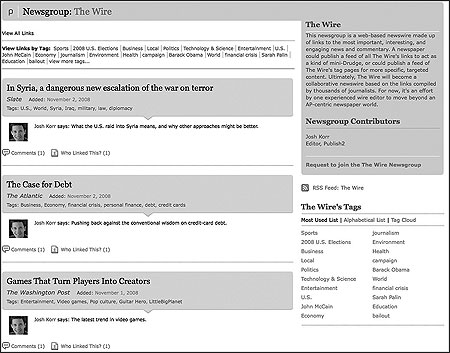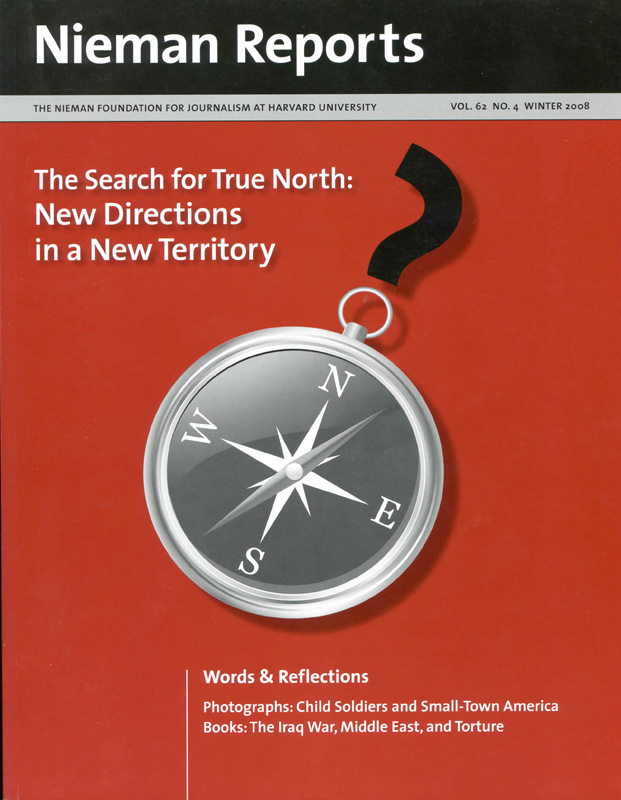Journalists may feel unmoored these days, but it’s not because they’ve lost their compass. True north will always be an independent press exercising its First Amendment right to inform and entertain fellow citizens, to investigate the powerful, and to provide a forum and voice for the community. The problem is that many newsrooms are using an outdated map, one that doesn’t show the modern news ecosystem’s infrastructure: the link.
The news media’s future is online, and the Web’s foundation is the link. The Web is literally a collection of linked pages—and, by extension, of linked people and knowledge. But news organizations have traditionally treated their Web sites as just another place to republish print stories, rather than as nodes in the larger Web media network. They didn’t see the value they could create for readers by connecting them to other sources and curating the Web’s flood of information.
This mindset is changing as the digital transition accelerates. Most news organizations have staff blogs that link to news and sources on other sites, and a smaller number are experimenting with dedicated pages of curated links to interesting and important content elsewhere on the Web. But there hasn’t been an easy way for news organizations to find and publish links even if they wanted to. What’s needed is a way for journalists to easily discover links to relevant content and for newsrooms to integrate links into their editorial workflow.
I’ve been working on a way of incorporating links into the everyday practice of journalism: It’s a wire service based on links rather than licensed content, which would enable newsrooms to develop a new practice of “link journalism.”
The Web provides instant access to nearly every credible print publication in the world, not to mention thousands of blogs and Web sites written by experts, academics and journalists. Yet most news organizations’ nonlocal coverage draws heavily from a small number of wire services, chiefly The Associated Press.
RELATED ARTICLE
Read a story by Jim Kennedy, director of strategic planning at AP, about the AP’s new approach to news reporting »Basic wire coverage still plays an essential role—the AP is usually the first to report on major stories, particularly in out-of-the-way places. But it has also contributed to the spread of what, in my work as a wire editor, I came to think of as the AP’s house style: voiceless, incrementally updated, process-oriented, one sentence of “news” stretched to 12 paragraphs. Such stories aren’t always engaging or interesting, nor are they effective in providing understanding. Without context, they can induce news overload.
Meanwhile, for any given news story, the more interesting and informative takes often come from sources other than the traditional newswires. On any given day, these days, the stuff that actually makes people smile is found not in newspapers or wire stories, but in viral videos and pop culture blogs. The longer newsrooms ignore the Web’s amazing universe of content, the less relevant they become for readers. The longer wire services fail to help newsrooms find this content, the less useful they will be.
But no one entity—be it a wire service or a news organization—can possibly track what’s appearing in all papers, large and small, blogs, magazines and Web sites. Nor could any one news organization acquire the rights to all of this material. The great thing about the Web is that you don’t have to pay anyone to help you bring great stories to readers—just link to ones already there.
Finding all of the good stuff is the challenge, so that’s the real mission of a Web-era wire service. It’s not to provide full-text versions of a handful of sources’ news, but to offer links to the best stuff culled from all sources.
Curating the Web
RELATED WEB LINK
The WireMy online link-based newswire—called The Wire—is created by using a free Web application called Publish2. Every day I go through a packed RSS reader and save links on all manner of topics from all kinds of sources. Just as newspaper wire editors apply editorial judgment when they select stories off the wires, I apply judgment when selecting links for The Wire. My goal is to provide a thorough, engaging wire for news organizations that want to start moving beyond the AP or are forced to do so for budgetary reasons. Any news organization can publish a feed of links from The Wire on its site or set up a Publish2 account to curate its own links, drawing from The Wire as a starting point.
My experiment is fine for a start, but it’s nothing compared to the potential of a wire service seeded by links from thousands of journalists using their editorial judgment to collaboratively filter and curate the Web.
How would such a collaboration work? It starts in four ways.
- Journalists save links to interesting stories in the course of everyday reading and publish those links on their news organization’s site or on a personal blog—effectively acting as link bloggers recommending good stuff to read.
- Journalists save links—to related stories, documents, interviews—in the course of their reporting, privately first, and then publish the links along with their articles.
- Journalists link stories specifically for a newswire—either the aggregate newswire or a smaller one based on a Publish2 newsgroup. (Newsgroups are a way for newsrooms to collaborate on creating news aggregation features based on links.)
- News organizations and freelancers add their own work to the link newswire—not for the sake of flooding the network with self-promoted material, but because they believe their work might interest other journalists and readers.
Next, this collection of links begins to act as a recommendation service for other journalists. Editors could then start their searches by viewing the most-linked stories for that day and seeing the wisdom of newsrooms that has bubbled to the top. Because the link effort is distributed—whether across or within newsrooms—and saving links is a simple and quick process, linking can fit smoothly into journalists’ daily routines.
EDITOR’S NOTE
In our Summer 2008 issue, two articles were about link journalism at the Knoxville News Sentinel on Super Tuesday. Scott Karp, CEO of Publish2, wrote “Linking Newspaper Readers to the Best Political Coverage,” and Jack Lail, managing editor/multimedia at the News Sentinel, wrote “Election Coverage Becomes a Time for ‘Instant Innovation.’”This kind of link wire service is useful mostly for nonlocal coverage, but it also offers lessons for newsrooms’ local reporting. For example, just as newsrooms should link to the best explainers of complex stories, such as the financial crisis, routine city council stories should link to explanations of terms like “zoning” that readers might not understand. Linking to source material strengthens local stories by making them more transparent. And newsrooms that link to local bloggers can help their communities find the best of the local blogosphere and get some links sent back in return.
Linking should not be seen as a replacement for original reporting. Indeed, without original reporting there would be nothing to link to. At the same time, links are the way that great reporting gets distributed and noticed on the Web. And by combining this reporting with links to interesting nonlocal stories, news organizations can remain vital daily news destinations.
Just imagine this scenario: Re-engaged readers flock to news sites. A bigger audience develops for news organizations’ original reporting as thousands of networked newsrooms link to one another. Greater transparency fosters a renewed sense of trust in journalism. And a new business model emerges, in which a link newswire creates a new marketplace for news that advertisers could tap into—transforming the newswire from a cost center into a profit center.
That’s a future worth linking for.

Josh Korr is editor of The Wire, an online link journalism project that has been developed through Publish2.


